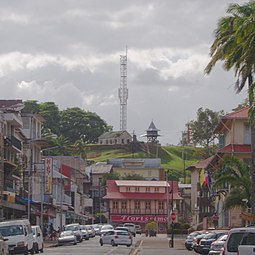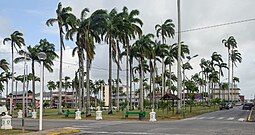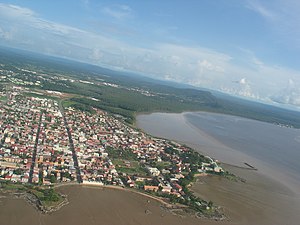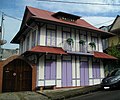Cayenne
Cayenne | |
|---|---|
From top to bottom, left to right: View of the Mount and Fort Cépérou, Place des Palmistes, French Guiana Prefecture Building, Place Léoplod-Héder, City Hall | |
 Location of the commune (in red) within French Guiana | |
| Coordinates: 4°56′14″N 52°19′34″W / 4.9372°N 52.3260°W | |
| Country | France |
| Overseas region and department | French Guiana |
| Arrondissement | Cayenne |
| Intercommunality | CA Centre Littoral |
| Government | |
| • Mayor (2020–2026) | Sandra Trochimara[1] |
| Area 1 | 23.60 km2 (9.11 sq mi) |
| • Urban (2020) | 206.9 km2 (79.9 sq mi) |
| • Metro (2020) | 5,087 km2 (1,964 sq mi) |
| Population (2021)[2] | 63,468 |
| • Density | 2,700/km2 (7,000/sq mi) |
| • Urban (Jan. 2021[3]) | 125,552 |
| • Urban density | 610/km2 (1,600/sq mi) |
| • Metro (Jan. 2021[4]) | 151,103 |
| • Metro density | 30/km2 (77/sq mi) |
| Demonym | Cayennais |
| Time zone | UTC−03:00 |
| INSEE/Postal code | 97302 /97300 |
| 1 French Land Register data, which excludes lakes, ponds, glaciers > 1 km2 (0.386 sq mi or 247 acres) and river estuaries. | |
Cayenne (/keɪˈɛn/;[5] French pronunciation: [kajɛn] ; Guianese Creole French: Kayenn) is the prefecture of French Guiana, an overseas region and department of France located in South America and its capital city. The city stands on a former island at the mouth of the Cayenne River on the Atlantic coast. The city's motto is "fert aurum industria", which means "work brings wealth".[6] Cayenne is the largest Francophone city of the South American continent.
In the 2021 census, there were 151,103 inhabitants in the metropolitan area of Cayenne (as defined by INSEE),[4] 63,468 of whom lived in the city (commune) of Cayenne proper.[7]
History
[edit]
French colonial empire 1643–1658
Dutch Empire 1658–1664
French colonial empire 1664–1676
English Empire 1667
Dutch Empire 1676
French colonial empire 1676–1809
Portuguese Empire 1809–1815
United Kingdom of Portugal, Brazil and the Algarves 1815–1817
France 1817–present
Ignored by Spanish explorers who found the region too hot and poor to be claimed, the region was not colonized until 1604, when the French founded a settlement. However, it was soon destroyed by the Portuguese, determined to enforce the Treaty of Tordesillas. French colonists returned in 1643 and founded Cayenne, but were forced to leave once more following the Amerindian attacks. In 1664, France finally established a permanent settlement at Cayenne. Over the next decade the colony changed hands between the French, Dutch, and English, before being restored to France. It was captured by an Anglo-Portuguese force in 1809 and administered from Brazil until 1814, when it was returned to French control. It was used as a French penal colony from 1854 to 1938.

The city's population has grown dramatically over time, owing to high levels of immigration (chiefly from the West Indies and Brazil) as well as a high birth rate.
Geography
[edit]Cayenne is located on the estuary of the Cayenne River on the Atlantic Ocean. The city occupies part of Cayenne Island. It is 268 kilometres (167 mi) from Saint-Laurent-du-Maroni and 64 kilometres (40 mi) from Kourou.[8]
Distances to some cities:
- Paris: 7,100 kilometres (4,400 mi).
- Fort-de-France, capital of Martinique: 1,500 kilometres (930 mi).[9]
- Nouméa, capital of New Caledonia (France) : 15,427 kilometres (9,586 mi)
- Paramaribo, capital of Suriname: 342 kilometres (213 mi) to the northwest
- Macapá, capital of the state of Amapá, Brazil: 554 kilometres (344 mi) to the southeast
- Mexico City, capital of Mexico: 5,534 kilometres (3,439 mi) to the northwest
- San Diego, southwestern city in California, United States: 7,363 kilometres (4,575 mi) to the northwest
Administration
[edit]
Cayenne is a commune of the French Republic and as such, administered by a mayor and a municipal council. The current mayor is Sandra Trochimara, who was 1st deputy mayor under the former mayor Marie-Laure Phinéra-Horth, and succeeded her as mayor of Cayenne in October 2020 after Phinéra-Horth won the local Senate race the month before (under French law, members of the French Senate cannot exercise the mandate of mayor). Marie-Laure Phinéra-Horth, a former member of the Guianese Socialist Party, daughter of a former president of the General Council of French Guiana, Stéphan Phinéra-Horth, from the Guianese Socialist Party, who governed the department of French Guiana from 1994 to 1998, was supported by various left-wing parties and had been mayor of Cayenne since 2010.[11][12]

As in the rest of France, the small size of the commune of Cayenne does not cover the entire urban area of Cayenne. This has led to the creation of an intercommunal authority which groups Cayenne and five suburban communes: the communauté d'agglomération du Centre Littoral. The current president of the intercommunal authority of Centre Littoral since November 2020 has been Serge Smock, mayor of Matoury, who ran on a centrist platform affiliated with Emmanuel Macron's LREM party and defeated Sandra Trochimara, successor of Marie-Laure Phinéra-Horth as mayor of Cayenne, who was also trying to succeed her as president of the intercommunal authority with the support of an array of Left-wing parties. It is the first time since 2001 that the intercommunal authority is not presided by the mayor of Cayenne.[13] Marie-Laure Phinéra-Horthwas was president of the intercommunal authority of Centre Littoral from 2014 to 2020, and did not run for reelection due to her election to the French Senate in September 2020.
The intercommunal authority of Centre Littoral, which levies its own taxes, is in charge of refuse collection, water supply and sewage treatment, urban planning, and public transport for the 5,087 km2 (1,964 sq mi) of Cayenne and its suburbs.
Until 2015, the commune of Cayenne was divided into six cantons, but these were abolished in 2015 when the department and the region of French Guiana were abolished and replaced by the French Guiana Territorial Collectivity.
Population
[edit]
|
| ||||||||||||||||||||||||||||||||||||||||||||||||||||||||||||||||||||||||||||||||||
Demographics
[edit]The places of birth of the 121,490 residents in the Cayenne metropolitan area at the 2012 census were as follows:[16]
- 56.5% were born in French Guiana
- 12.0% in Metropolitan France
- 3.0% in Martinique
- 1.4% in Guadeloupe
- 0.3% in other parts of Overseas France
- 26.7% in other foreign countries (notably Haiti and Brazil, followed by Suriname and Guyana); among these, 25.0% were immigrants and 1.7% were children of French citizens born abroad
These were the countries of birth of the immigrants living in the Cayenne metropolitan area at the 2009 census:[17]
- born in Haiti: 12,184
- born in Brazil: 7,627
- born in Suriname: 2,691
- born in Guyana: 2,537
- born in China: 924
- born in other countries: 3,713
Health
[edit]Health conditions in Cayenne and French Guiana are generally good. The principal illnesses that cause mortality are circulatory, infectious and parasitic diseases, as well as cancer. A branch of the Pasteur Institute in Paris, located in Cayenne, conducts research on tropical and endemic local diseases and is renowned throughout Latin America. Life expectancy averages about 76 years for men and 83 years for women.[18] The main hospital of the city is the Andrée-Rosemon Hospital which opened in 1992.[19]
Economy
[edit]
Cayenne is an important seaport in South America. The major port of Dégrad des Cannes is on the estuary of the river Mahury, replacing Larivot and the Îles du Salut. Timber, rosewood essence, rum, and gold are exported in small quantities. In the mid-1960s sugarcane and pineapple were planted around the city, and a pineapple cannery and a shrimp-processing plant were later built. A seafront avenue links Cayenne with the suburbs of Chaton and Montabo, where the French Institute of Tropical America and the Pasteur Institute are located. Historic landmarks include the Church of the Holy Saviour and a prefecture on the Place d'Armes. The Félix Eboué International Airport is the only international airport serving Cayenne.[20]

Climate
[edit]Under the Köppen climate classification, Cayenne has a tropical monsoon climate (Am) bordering on an equatorial climate (Af). Average high and low temperatures are nearly identical throughout the course of the year, averaging about 30 °C (86 °F) and 23 °C (73 °F) respectively, although temperatures are somewhat cooler in the wet season than in the dry season. Cayenne sees copious precipitation during the year, with its weather being more strongly affected by the Intertropical Convergence Zone (ITCZ) than the trade winds. The city experiences a very lengthy wet season and a very short dry season – the dry season covers only August to October, while the wet season covers the remainder of the year. Some precipitation is seen even during the dry season, a trait common in tropical climates. Cayenne averages roughly 3,500 millimetres (140 in) of rain each year.
| Town | Sunshine (hours/yr) |
Rain (mm/yr) |
Snow (days/yr) |
Storm (days/yr) |
Fog (days/yr) |
|---|---|---|---|---|---|
| National average | 1,973 | 770 | 14 | 22 | 40 |
| Cayenne | 2,072 | 3,515.6 | 0 | 39.7 | 34.1[22] |
| Paris | 1,661 | 637 | 12 | 18 | 10 |
| Nice | 2,724 | 767 | 1 | 29 | 1 |
| Strasbourg | 1,693 | 665 | 29 | 29 | 56 |
| Brest | 1,605 | 1,211 | 7 | 12 | 75 |
| Climate data for Cayenne (CAY, altitude 4m, 1991–2020 normals, extremes 1948–present) | |||||||||||||
|---|---|---|---|---|---|---|---|---|---|---|---|---|---|
| Month | Jan | Feb | Mar | Apr | May | Jun | Jul | Aug | Sep | Oct | Nov | Dec | Year |
| Record high °C (°F) | 32.5 (90.5) |
32.3 (90.1) |
32.2 (90.0) |
33.0 (91.4) |
33.8 (92.8) |
34.4 (93.9) |
34.5 (94.1) |
35.0 (95.0) |
35.2 (95.4) |
35.4 (95.7) |
34.6 (94.3) |
34.1 (93.4) |
35.4 (95.7) |
| Mean daily maximum °C (°F) | 29.3 (84.7) |
29.3 (84.7) |
29.7 (85.5) |
30.0 (86.0) |
30.1 (86.2) |
30.5 (86.9) |
31.1 (88.0) |
31.8 (89.2) |
32.4 (90.3) |
32.5 (90.5) |
31.7 (89.1) |
30.3 (86.5) |
30.7 (87.3) |
| Daily mean °C (°F) | 26.4 (79.5) |
26.4 (79.5) |
26.7 (80.1) |
26.9 (80.4) |
26.8 (80.2) |
26.8 (80.2) |
26.8 (80.2) |
27.2 (81.0) |
27.4 (81.3) |
27.5 (81.5) |
27.2 (81.0) |
26.7 (80.1) |
26.9 (80.4) |
| Mean daily minimum °C (°F) | 23.4 (74.1) |
23.5 (74.3) |
23.6 (74.5) |
23.8 (74.8) |
23.6 (74.5) |
23.0 (73.4) |
22.5 (72.5) |
22.5 (72.5) |
22.5 (72.5) |
22.4 (72.3) |
22.7 (72.9) |
23.2 (73.8) |
23.1 (73.6) |
| Record low °C (°F) | 17.4 (63.3) |
18.9 (66.0) |
18.5 (65.3) |
19.0 (66.2) |
18.8 (65.8) |
18.9 (66.0) |
19.0 (66.2) |
19.0 (66.2) |
18.7 (65.7) |
18.6 (65.5) |
17.2 (63.0) |
18.8 (65.8) |
17.2 (63.0) |
| Average precipitation mm (inches) | 399.4 (15.72) |
334.8 (13.18) |
315.4 (12.42) |
443.2 (17.45) |
600.0 (23.62) |
392.2 (15.44) |
262.2 (10.32) |
135.4 (5.33) |
63.2 (2.49) |
54.9 (2.16) |
135.2 (5.32) |
352.3 (13.87) |
3,488.2 (137.33) |
| Average precipitation days (≥ 1.0 mm) | 22.8 | 20.5 | 20.4 | 22.1 | 26.6 | 25.2 | 21.2 | 14.0 | 6.4 | 6.4 | 12.4 | 21.5 | 219.6 |
| Average relative humidity (%) | 82 | 80 | 82 | 84 | 85 | 82 | 78 | 74 | 71 | 71 | 76 | 81 | 79 |
| Mean monthly sunshine hours | 102.4 | 90.2 | 117.3 | 121.1 | 121.4 | 153.2 | 200.1 | 231.3 | 250.8 | 256.6 | 208.1 | 150.3 | 2,002.8 |
| Source: Meteo France[23][24] | |||||||||||||
| Climate data for Cayenne (Suzuni, altitude 4m, 1991−2020 normals, extremes 1972−present) | |||||||||||||
|---|---|---|---|---|---|---|---|---|---|---|---|---|---|
| Month | Jan | Feb | Mar | Apr | May | Jun | Jul | Aug | Sep | Oct | Nov | Dec | Year |
| Record high °C (°F) | 31.4 (88.5) |
31.9 (89.4) |
32.2 (90.0) |
34.0 (93.2) |
33.4 (92.1) |
33.5 (92.3) |
34.4 (93.9) |
33.3 (91.9) |
34.4 (93.9) |
33.7 (92.7) |
33.6 (92.5) |
33.3 (91.9) |
34.4 (93.9) |
| Mean daily maximum °C (°F) | 28.7 (83.7) |
28.7 (83.7) |
29.0 (84.2) |
29.3 (84.7) |
29.2 (84.6) |
29.4 (84.9) |
30.0 (86.0) |
30.4 (86.7) |
30.7 (87.3) |
30.9 (87.6) |
30.4 (86.7) |
29.5 (85.1) |
29.7 (85.5) |
| Daily mean °C (°F) | 26.5 (79.7) |
26.5 (79.7) |
26.8 (80.2) |
27.1 (80.8) |
26.8 (80.2) |
26.5 (79.7) |
26.6 (79.9) |
27.0 (80.6) |
27.4 (81.3) |
27.7 (81.9) |
27.5 (81.5) |
27.0 (80.6) |
27.0 (80.6) |
| Mean daily minimum °C (°F) | 24.2 (75.6) |
24.4 (75.9) |
24.7 (76.5) |
24.8 (76.6) |
24.3 (75.7) |
23.6 (74.5) |
23.3 (73.9) |
23.7 (74.7) |
24.1 (75.4) |
24.5 (76.1) |
24.6 (76.3) |
24.5 (76.1) |
24.2 (75.6) |
| Record low °C (°F) | 20.3 (68.5) |
20.5 (68.9) |
21.4 (70.5) |
21.2 (70.2) |
21.2 (70.2) |
20.5 (68.9) |
20.4 (68.7) |
20.3 (68.5) |
20.3 (68.5) |
20.8 (69.4) |
20.5 (68.9) |
20.1 (68.2) |
20.1 (68.2) |
| Average precipitation mm (inches) | 370.9 (14.60) |
248.8 (9.80) |
259.8 (10.23) |
355.3 (13.99) |
517.9 (20.39) |
373.6 (14.71) |
155.2 (6.11) |
79.1 (3.11) |
39.3 (1.55) |
51.5 (2.03) |
104.8 (4.13) |
259.6 (10.22) |
2,815.8 (110.86) |
| Average precipitation days (≥ 1.0 mm) | 20.5 | 16.2 | 16.6 | 19.0 | 24.3 | 23.4 | 15.5 | 8.8 | 5.0 | 6.3 | 10.8 | 18.9 | 185.1 |
| Source: Météo-France[25] | |||||||||||||
Heritage
[edit]Saint-Sauveur Cathedral
[edit]
In 1823 Father Nicolas Guiller and Baron Pierre Bernard Milius, administrator of French Guiana, decided to replace the old church of Saint Nicolas on the current Place Léopold-Héder. Work began in 1825 and ended in 1833. The church was inaugurated in 1861 and is registered as a French monument historique.[26]
The high altar, the pulpit, and the confessional of the penitentiary chapel on the Îlet la Mère were transferred to the cathedral in 1876.
In 1933, the church was declared a cathedral. It was consecrated in November 1934 by monseigneur Pierre Gourtay, the first bishop of Guyana. In 1952, construction workers discovered a lead case containing 21 coins, the oldest of which dated to the Napoleonic period, and 20 seals from the reign of Charles X.
Between 1952 and 1954, the ceiling, the windows, and the floors of the tribunal were replaced. The bell tower was renovated in 2000–01.[27]
Fort Cépérou
[edit]Fort Cépérou, originally known as Fort Saint-Michel, is a 17th-century fortification on Mount Cépérou, named for the Amerindian chief who in 1643 sold the rock on which it stands to the Frenchman Charles Poncet de Brétigny, governor of Cayenne in 1644–1645.[28]
-
View of Cayenne from Fort Cépérou with belfry in foreground, May 2015.
-
View of the renovated pagoda
-
Fort Cépérou
Historic houses
[edit]
In recent years the city has renovated a number of historic Creole houses in the city center.
-
Restored creole house on the place du Coq.
-
Creole house restored as restaurant.
-
Restored créole home.
-
Creole building
-
Creole home, restored.
-
Restored creole home not far from Cépérou.
-
Creole house restored as a business
-
Creole house renovated into jewelry store.
-
Direction régionale des Affaires culturelles (HQ of Regional Administration for Cultural Affairs)
-
Downtown seen from the roof-tops.
-
Club Saint-Hubert in Cayenne.
Place des Palmistes
[edit]
Initially it was a plaza to aerate the city after the demolition of the city walls in 1810. It was named Place de la Savane ("Savanna Square") after the grasses that grew there. Later some royal palms from the area of Guisanbourg were planted there, and the plaza was renamed Place des Palmistes ("Royal Palms' Square"). In 1880, a bronze column was erected bearing the bust of the Marianne, commemorating the seizure of the Bastille. Governor Gaston Gerville-Reache transformed the plaza into an English garden, with artificial hills, masses of flowers and ornamental plants. Because it regularly flooded in the rain, Governor Marc Chanel in 1925 bordered it with a network of cemented canals, still there to this day. A statue of Félix Éboué, an illustrious Guianan, stands at the Merlet fountain.[29] Today it is a lively place where the residents meet. In the evening, food carts sell French fries, sandwiches, local juices and other street food, and bami and lassi (Javanese delicacies brought in by way of Suriname).
Botanical garden
[edit]
In 1786, Louis XVI had a garden that served as a storehouse and nursery for various plants and trees from various locations. Louis Claude Richard, director of the garden, brought from India nutmeg trees, rattan, cardamom and black pepper vines. At this period, it was called King's Garden. In 1821 a house was built for the botanist.[30] In 1879, the park changed its name and became the Botanical Garden, a floral park in the city center. It covers an area of three hectares. A statue of Gaston Monnerville stands in the garden's center.[31]
Market and Place du Coq
[edit]

These two adjoining buildings are located near the old port of Cayenne. As early as 1703, a Place du Port appears on a map of the city of Cayenne. It then became Place du Marché in 1842. In 1888, a covered market and a public garden were built there. In 1907 the municipal council led by mayor Eugène Gobert decided to remove the garden and build a new covered market, the one we know today. In 1920 the war memorial of the First World War was inaugurated on the site of the old market, surmounted by a rooster, which gave the place its current name.

Village Chinois
[edit]The village chionois (Chinese Village) in Cayenne is located on the edge of the city's center along the Cayenne River.[32] Colloquially known as la Crique or Chikago, the neighborhood is reportedly a top destination for internal migration from elsewhere in French Guiana.[33]
Culture
[edit]Carnival of Cayenne
[edit]The carnival is one of the major events of the capital. It takes place between Epiphany in early January and Ash Wednesday in February or March.
Description and origin
[edit]

This festival is part of the Guianan Creole culture. It was originally a carnival as practiced in Europe. In early colonial times, the settlers held the carnival, but it was forbidden to slaves. Braving the ban, slaves Held clandestine festivals to regain some freedom, celebrate Africans, fertility and harvest, and make fun of the settlers.
The fat days close the carnival:[34]
- Fat Sunday: day of the grand parade, the biggest carnival parade, where groups compete for prizes for their performance.
- Fat Monday: burlesque marriages; men dress up as brides and women as grooms.
- Mardi Gras (Fat Tuesday): carnival goers parade as Diab rouj (red devils), everyone dressed in red and black.
- Ash Wednesday: she-devils dressed all in black and white bury Vaval, the king of the carnival.
Carnival of the streets
[edit]Groups disguised according to the theme of the year march to the rhythm of drums and brass in a parade around decorated floats. These groups prepare for months for to parade in front of thousands of spectators massed on the sidewalks and the stands erected for the occasion.
The best-known groups are:
- Kassialata
- Reno Band
- OsBand
- les Belles de la Madeleine
Brazilian bands just like to those at the Rio Carnival are also appreciated for their alluring rhythms and costumes, and Asian community of Cayenne brings dragons to the parade as well.
Masked balls
[edit]
Nightclubs, called "universities" in this context, organize masked balls in which men come to dance with Touloulous at soirées held on Friday and Saturday nights. This tradition is peculiar to French Guiana, and does not exist anywhere else.
The carnival dances are the polka, mazurka, biguine and piké djouk. The Touloulou invite the men to dance, and the men cannot refuse. Only Touloulous have the right to dance, and if a undisguised woman tries to dance, the orchestra stops playing.[34]
Since the 1990s, tololo parties have been held where men disguise themselves and play the role of the Touloulous, inviting undisguised women to dance. These evenings are more and more popular and take place several times during the carnival.
The family carnival
Families gather every week to eat king cake, a European tradition observed throughout the carnival. The cake can be frangipane, cream, coconut or guava.
After the abolition of slavery in 1848, the economy of French Guiana was devastated, and much of the population lived by working the land in “habitations”. People farmed and knew the value of working together. The tradition of the king cake was born in the Guiana of this period, or more precisely, “rend le bouquet”. One couple organized the meal and celebration, and at its end designated the couple who would organize the following gathering by handing them the bouquet.
Main sights
[edit]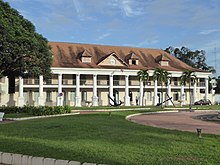

Cayenne centres on its main commercial street, the Avenue Général de Gaulle. At the east end of the avenue near the coast is the Place des Palmistes and the Place de Grenoble (also known as the Place Léopold Héder). Most of the official buildings are located in this area: the Hôtel de Ville (the town hall) built by Jesuits in the 1890s, the Post Office, the Préfecture, residence of French Guiana's Préfect, and the Musée Départmental Franconie. To the west of this area lies Fort Cépérou, built in the 17th century, though now mostly in ruins. To the south lie the Place du Coq and Place Victor Schoelcher (named in honour of the anti-slavery activist) and a market.
To the south of this compact region is the Village Chinois (known as Chicago), separated from the rest of Cayenne by the Canal Laussat. It has a reputation for being a dangerous area.
Other buildings in the city include Cayenne Cathedral, municipal library, the municipal museum and a museum of French Guianese Culture (Musée des Cultures Guyanaise) and a scientific research institute (IRD or Institut de recherche pour le développement, formerly Orstom). The Jardin botanique de Cayenne is the city's botanical garden.
Transport
[edit]Cayenne is served by the Cayenne – Félix Eboué Airport, which is located in the neighbouring commune of Matoury.
French Guiana's main seaport is the port of Dégrad des Cannes, located on the estuary of the Mahury River, in the commune of Remire-Montjoly, a south-eastern suburb of Cayenne. Almost all of French Guiana's imports and exports pass through the port of Dégrad des Cannes. Built in 1974, it replaced the old harbour of Cayenne which was congested and could not cope with modern traffic.[35][36]
Cayenne is connected to Saint-Laurent-du-Maroni via the Route nationale 1, and to Saint-Georges via the Route nationale 2.[37]
Education
[edit]Cayenne is home to the University of French Guiana, formerly a campus of the University of the French West Indies until a strike concerning university funding led to the creation of a separate institution in 2014.[38]
In popular culture
[edit]
In The Hardy Boys #12: Footprints Under the Window, the Hardys' investigations take them to Cayenne.
The 1955 film We're No Angels involves three prisoners who escaped from Devil's Island and settled incognito into a family store in Cayenne.[39]
Notable people
[edit]- Élie Castor, politician and author
- Léon Damas, poet and politician
- Eddy Gaumont, jazz musician
- Antoine Karam, politician
- Gaston Monnerville, politician
- Suzanne Amomba Paillé, planter and philanthropist
- Henri Salvador, comedian and singer
- Gabriel Serville, politician
- Christiane Taubira, politician
- Sylviane Vayaboury, author
- Mike Maignan, footballer
See also
[edit]- Cayenne (Dutch colony)
- Cayenne pepper
- Communes of French Guiana
- Îlet la Mère, island belonging to Cayenne
- List of colonial and departmental heads of French Guiana
References
[edit]- ^ "Répertoire national des élus: les maires" (in French). data.gouv.fr, Plateforme ouverte des données publiques françaises. 13 September 2022.
- ^ "Populations légales 2021" (in French). The National Institute of Statistics and Economic Studies. 28 December 2023.
- ^ INSEE. "Statistiques locales - France par unité urbaine - Population municipale (historique depuis 1876)2021". Retrieved 25 September 2024.
- ^ a b c INSEE. "Statistiques locales - France par aire d'attraction des villes - Population municipale (historique depuis 1876)2021". Retrieved 25 September 2024.
- ^ Cayenne Archived 6 April 2016 at the Wayback Machine, Oxford Dictionaries
- ^ "page concernant le blason de la ville sur le site page de Redris". Pagesperso-orange.fr. Archived from the original on 26 December 2008. Retrieved 13 March 2011.
- ^ a b INSEE. "Population en historique depuis 1968" (in French). Retrieved 25 September 2024.
- ^ "Distances and duration of bonds in the dugout". Archived from the original on 12 June 2013. Retrieved 7 August 2011.
- ^ Situation Géographique Préfecture de Guyane, archived 15 September 2008 from the original
- ^ Confins (2018). "Avancées et reculs de la mangrove à Cayenne". Confins. 34 (34). doi:10.4000/confins.12829. Archived from the original on 12 January 2019. Retrieved 12 January 2019.
- ^ "Sénatoriales : Marie-Laure Phinéra-Horth devient la 1ère femme sénatrice de la Guyane". Guyane la 1ère (in French). 27 September 2020. Retrieved 4 April 2022.
- ^ "Mme Marie-Laure Phinera-Horth, sénatrice de la Guyane (Guyane) - Sénat". www.senat.fr. Retrieved 8 April 2022.
- ^ Guyane La Première (6 November 2020). "Serge Smock élu président de la communauté d'agglomération du centre littoral". Retrieved 2 April 2022.
- ^ a b La Guyane française, page 33, Gérard Brasseur
- ^ INSEE. "Statistiques locales - France par aire d'attraction des villes - Population municipale (historique depuis 1876)". Retrieved 2 April 2022.
- ^ "Recensement de la population de 2012 – Individus localisés au canton-ou-ville en 2012". INSEE. Archived from the original on 24 February 2019. Retrieved 2 February 2019.
- ^ "Panorama de la population immigrée en Guyane" (PDF). INSEE. Archived (PDF) from the original on 3 February 2019. Retrieved 2 February 2019.
- ^ "French Guiana | history – geography – territorial collectivity, France". Encyclopædia Britannica. Archived from the original on 27 November 2016. Retrieved 8 December 2016.
- ^ "Centre Hospitalier de Cayenne Andrée Rosemon (Cayenne)". Hopital.fr (in French). Retrieved 6 May 2020.
- ^ "Cayenne | French Guiana". Encyclopædia Britannica. Archived from the original on 20 December 2016. Retrieved 8 December 2016.
- ^ Paris, Nice, Strasbourg, Brest
- ^ "Normales climatiques 1981-2010 : Cayenne". www.lameteo.org. Retrieved 28 August 2022.
- ^ "Climatological Information for Cayenne, France". Meteo France. 7 August 2019. Archived from the original on 27 July 2020. Retrieved 31 December 2021.
- ^ "CAYENNE–MATOURY (973)" (PDF). Fiche Climatologique: Statistiques 1981–2010 et records (in French). Meteo France. Retrieved 28 August 2022.
- ^ "Fiche Climatologique Statistiques 1991-2020 et records" (PDF) (in French). Météo-France. Retrieved 28 August 2022.
- ^ Cathédrale Saint-Sauveur de Cayenne Archived 1 November 2013 at the Wayback Machine.
- ^ Base Mérimée: Cathédrale Saint-Sauveur, Ministère français de la Culture. (in French)
- ^ "Fort Cépérou". Le Petit Futé. Retrieved 24 January 2020.
- ^ Base Mérimée: Place de l'Esplanade dite Place des Palmistes, Ministère français de la Culture. (in French)
- ^ Base Mérimée: Ancien jardin du roi devenu jardin botanique, Ministère français de la Culture. (in French)
- ^ Article sur le Jardin Botanique Archived 19 November 2008 at the Wayback Machine sur le site internet du Conseil Général.
- ^ "Santé et logement : comment accompagner la Martinique et la Guyane ?". Sénat. 12 July 2011. Retrieved 19 June 2022.
- ^ Parlan, Valeire (30 October 2018). "Au village Chinois, une asso se bat pour offrir une vie meilleure aux jeunes Guyanais". StreetPress (in French). Retrieved 19 June 2022.
- ^ a b "Le Carnaval – Une institution en Guyane" [Carnival: An Institution in Guiana]. guyane-guide.com. 17 August 2005. Retrieved 17 January 2020.
- ^ "Nouvelle génération sur la Guyane". Jeune Marine (in French). Retrieved 3 January 2022.
- ^ "Degrad des Cannes". Marfret. Retrieved 3 January 2022.
- ^ "La sécurité routière en Guyane" (PDF) (in French). Ministère de l'Écologie, du Développement durable, des Transports et du Logement. 2010. Retrieved 19 March 2021.
- ^ nouvelobs.com/education/20140121.AFP8128/decret-sur-le-statut-experimental-de-l-universite-de-guyane-fin-janvier-fioraso.html
- ^ https://m.imdb.com/title/tt0048801/ Imdb [user-generated source]
External links
[edit] Cayenne travel guide from Wikivoyage
Cayenne travel guide from Wikivoyage- . Encyclopædia Britannica. Vol. 5 (11th ed.). 1911.
- Préfecture de Guyane Official website

